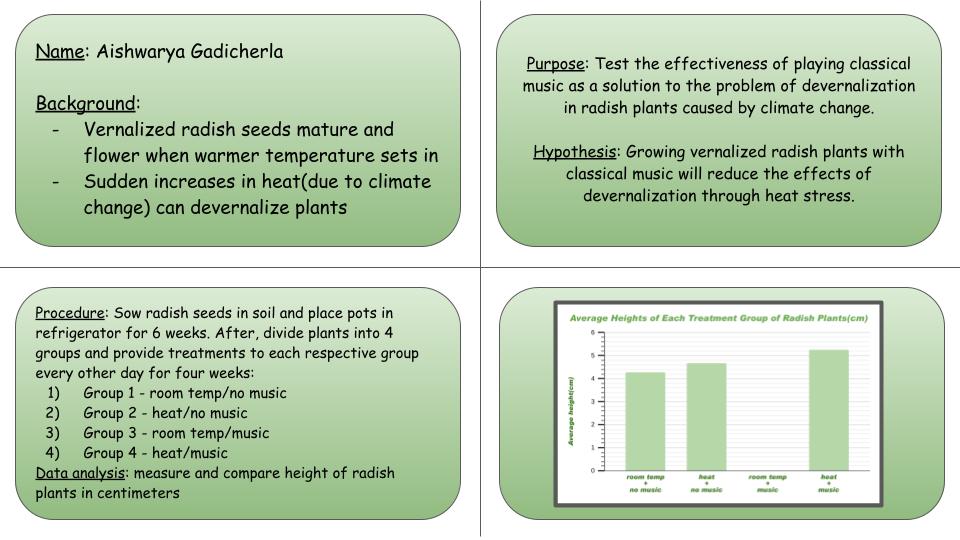The Effects of Classical Music on the Growth of Vernalized Radish Plants
Abstract:
Bibliography/Citations:
No additional citationsAdditional Project Information
Research Plan:
Rationale:
Radish, also known as Raphanus sativus L., is one of the most popular homegrown vegetables because of its rapid growth cycle and minimal maintenance requirements. Traditionally, radish seeds are sown in the spring when temperatures are between 12 to 24 degrees Celsius, facilitating their vernalization process. This strategy ensures that as warmer weather and longer days set in, the radish roots are matured fully before flowering occurs, optimizing both flavor and texture. Nonetheless, a common challenge faced by many gardeners arises when radishes prematurely bolt to seed due to a drastic rise in temperature that exceeds 26 degrees Celsius, or 80 degrees Fahrenheit. This premature flowering leads to a bitter, undesirable taste and texture, rendering the radishes unsuitable for consumption and ultimately wasted. Previously, a study on the vernalization of Raphanus sativus L. has allowed scientists to conclude that the resulting histone modification suppresses the expression of Glucoraphasatin Synthase 1(GRS1). This down-regulates the glucosinolates, the metabolic genes known to defend the organism against environmental stresses. Therefore, the radish plants are made to be more susceptible to drastic increases in temperature during the summer. A possible solution to this issue is the use of classical music. The effects of classical music on the heat stress response of Arabidopsis Thaliana, a typical model plant organism, have been studied by scientists that found that it caused an increased expression of heat-responsive genes. This experiment is designed to test the effectiveness of water on the maintenance of a vernalized state in radish plants.
Materials:
- 8 Jiffy 3-inch Peat Pots
- 16 Radish seeds from Carolina Biological Supply
- Pro-Mix for Potting & Seeding
- Refrigerator set to 4 degrees Celsius
- Incubator(Incu-Shaker Mini from Benchmark Scientific)
- Plant Light House with Light Bulbs from Carolina Biological Supply
- Plastic Cling Wrap
- Ruler
- Computer(or device with bluetooth)
- Tribit XSound Go Bluetooth Speaker
Procedure:
- Planted/Vernalized the radish seeds:
- Each pot was filled with soil mix until about an inch from the rim
- With tweezers or a toothpick, two seeds were placed, about an inch apart from each other, about a half inch into the soil of each pot.
- The pots were divided into four groups and labeled according to the treatment they were going to be receive
- Group 1: Room temperature + No music
- Group 2: Heat + No Music
- Group 3: Room temperature + Music
- Group 4: Heat + Music
- The seeds were watered sufficiently and placed in the refrigerator for six weeks
- After the six weeks, the vernalized seeds were removed from the fridge. Plastic cling wrap was used to cover the top of the pots in order to maintain moisture within the plants that were then moved into the Plant Light House. The plastic wrap was removed and the plants watered before administration of each treatment(approximately every other day).
- Treatment for groups 1 and 4 were administered at the same time. Treatment for groups 2 and 3 were administered at the same time:
- Group 1 plants were removed from the Plant Light House and placed in front of a window for one hour before covering them back up with plastic cling wrap and putting them back in the Plant Light House
- The blue tooth speaker was connected to a laptop, or other device, and classical music was played("Classical Music for Studying & Brain Power | Mozart, Vivaldi, Tchaikovsky..." on YouTube). Then, the Group 4 plants were placed in the incubator, with the temperature set to 30 degrees Celsius, along with the blue tooth speaker for one hour. The volume setting of the speaker was noted to ensure the music was played at the same volume for every treatment. After, the plants were covered with plastic wrap and put inside the Light House.
- Then, the Group 4 plants were replaced in the incubator with Group 2 plants and the bluetooth speaker was removed from inside. After an hour, the plants were covered with plastic wrap and placed inside the lighthouse.
- Group 3 plants were placed near a window next to the blue tooth speaker and music was played for one hour.
- Plants were treated every other day for four weeks and their growth was monitored over time.
- Data collection/analysis: After the treatments, the height of each plants was measured in centimeters and recorded. The average height of the plants in each group was calculated and compared for analysis.

